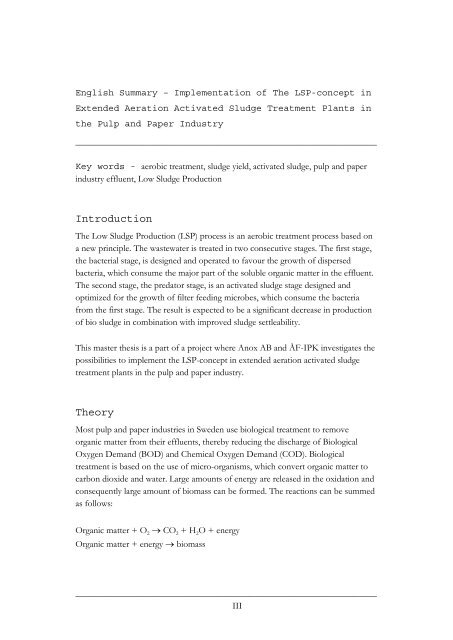Implementation of The LSP-concept in Extended Aeration
Implementation of The LSP-concept in Extended Aeration
Implementation of The LSP-concept in Extended Aeration
- No tags were found...
You also want an ePaper? Increase the reach of your titles
YUMPU automatically turns print PDFs into web optimized ePapers that Google loves.
English Summary – <strong>Implementation</strong> <strong>of</strong> <strong>The</strong> <strong>LSP</strong>-<strong>concept</strong> <strong>in</strong><br />
<strong>Extended</strong> <strong>Aeration</strong> Activated Sludge Treatment Plants <strong>in</strong><br />
the Pulp and Paper Industry<br />
__________________________________________________________________<br />
Key words - aerobic treatment, sludge yield, activated sludge, pulp and paper<br />
<strong>in</strong>dustry effluent, Low Sludge Production<br />
Introduction<br />
<strong>The</strong> Low Sludge Production (<strong>LSP</strong>) process is an aerobic treatment process based on<br />
a new pr<strong>in</strong>ciple. <strong>The</strong> wastewater is treated <strong>in</strong> two consecutive stages. <strong>The</strong> first stage,<br />
the bacterial stage, is designed and operated to favour the growth <strong>of</strong> dispersed<br />
bacteria, which consume the major part <strong>of</strong> the soluble organic matter <strong>in</strong> the effluent.<br />
<strong>The</strong> second stage, the predator stage, is an activated sludge stage designed and<br />
optimized for the growth <strong>of</strong> filter feed<strong>in</strong>g microbes, which consume the bacteria<br />
from the first stage. <strong>The</strong> result is expected to be a significant decrease <strong>in</strong> production<br />
<strong>of</strong> bio sludge <strong>in</strong> comb<strong>in</strong>ation with improved sludge settleability.<br />
This master thesis is a part <strong>of</strong> a project where Anox AB and ÅF-IPK <strong>in</strong>vestigates the<br />
possibilities to implement the <strong>LSP</strong>-<strong>concept</strong> <strong>in</strong> extended aeration activated sludge<br />
treatment plants <strong>in</strong> the pulp and paper <strong>in</strong>dustry.<br />
<strong>The</strong>ory<br />
Most pulp and paper <strong>in</strong>dustries <strong>in</strong> Sweden use biological treatment to remove<br />
organic matter from their effluents, thereby reduc<strong>in</strong>g the discharge <strong>of</strong> Biological<br />
Oxygen Demand (BOD) and Chemical Oxygen Demand (COD). Biological<br />
treatment is based on the use <strong>of</strong> micro-organisms, which convert organic matter to<br />
carbon dioxide and water. Large amounts <strong>of</strong> energy are released <strong>in</strong> the oxidation and<br />
consequently large amount <strong>of</strong> biomass can be formed. <strong>The</strong> reactions can be summed<br />
as follows:<br />
Organic matter + O 2 Æ CO 2 + H 2 O + energy<br />
Organic matter + energy Æ biomass<br />
__________________________________________________________________<br />
III

















